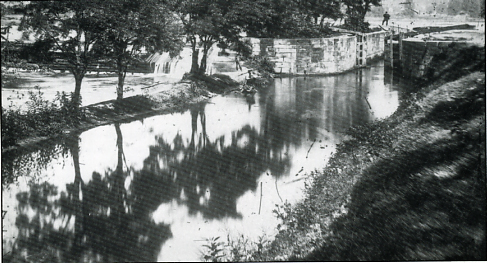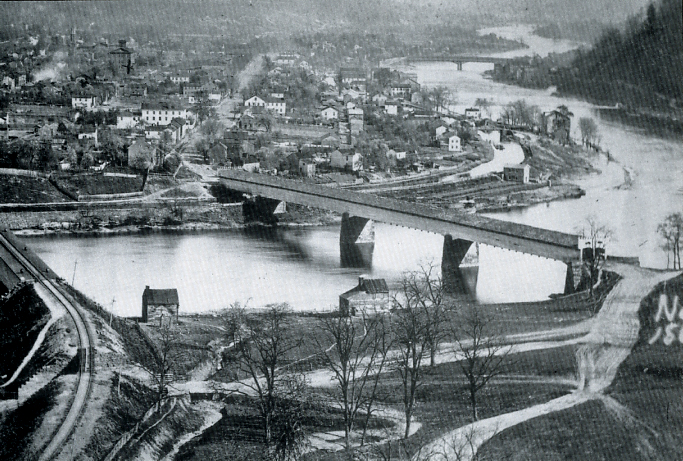
An early picture of Dutchman's Lock in New Brighton.
Click Here to Return to Milestones
The era of canal building in the United
States marked a great forward step in transportation history.
Whereas, formerly the traveler wearied himself jolting over the
rough and uneven roadway in a crude stage-coach, now he might
relax quietly in a comfortable seat on ship-board as the boat
was drawn over the canal by the trotting horses on the tow path.
In like fashion the manufacturer now no longer need depend on
the small, slow wagons of the overland freighter, but could use
large canal boats. So the canal era brought cheaper and more rapid
transportation which meant much to the factory owner.
Ground was broken for the Beaver division on July 28, 1831, at
New Brighton. It was considered such a momentous event in the
history of Beaver County, that a great celebration was held in
the grove near the foot of Thirteenth Street. Major Robert Darragh
was president of the day; M. F. Champlin, chief marshal; and Major
B. A. Goll, assistant marshal of the ceremony. All of these men
were prominent in the public life of the Beaver Valley. The ground
was broken by Revolutionary soldiers amid the firing of cannon
and cheers of the assemblage. A dinner followed, and then the
main address of the day was delivered by John Dickey. Toasts were
given by prominent men of the surrounding counties. Work on the
canal commenced the next day and continued uninterruptedly until
the division was finished three years later.

In New Brighton the canal left the river
at Fourteenth Street and passed through the town, meeting the
main stream at the lock opposite Fourth Street, Beaver Falls.
A short stretch of canal with two locks was necessary to pass
the upper falls into the 7 mile pool above the Eastvale dam. One
of the locks was about opposite 20th Street, Beaver Falls, and
the other near the dam. By this step a bad bend in the river was
overcome. It also kept the canal from interfering with the Fallston
dam across the river that furnished power for manufacturing plants
that were along the Beaver River at that time.
Within the borough limits of New Brighton, there were four single
and one double lock. The latter was located between Tenth and
Eleventh Streets. These were locally named after their respective
lock tenders as follows: Fourteenth Street--"Van Lear's"
; Thirteenth Street--"Butt Cut"; Eleventh Street--"Buck"
Wood's; Tenth Street-"Blounts"; and Beaver Falls Dam-"Dutchman's
or "Gasper Whitesell's."
The ticket office where tolls for the use of the several locks,
passenger traffic and local business of the canal was transacted
stood on the east side of the waterway almost in the rear of the
present Beaver County Trust Building site. Freight for transfer
was consigned to Benjamin Bedison & Son, commission merchants,
and the Bedison warehouse was between the canal and the river
just south of Ninth Street. Ordinary light freight was placed
in the Bedison depot, but staves, pig iron, copper and other heavy
materials were unloaded at what was known as the bulkhead, between
Sixth and Seventh Streets, which was the nearest available place
to the railway station at Eighth Street. Nearly all the copper
ore used in the early large smelting works at Pittsburgh came
from Lake Superior and was transported via the canal through New
Brighton.

When the Ohio river had sufficient water, ladened canal boats
went through to Rochester and were taken twice a week by two steamboats,
"Storm No. 1" and "Storm No. 2" to the city.
Ten to 15 were lashed together and towed at one trip. New Brighton
was used as a transfer point only at low water in the Ohio. The
local ticket agent over a long period of time was Harry Mills.
Between Sixth and Seventh Streets, on the west side of the canal,
a dry-dock was built where canal boats were repaired. Two bridges
crossed the canal, one at Ninth Street and another at Sixth Street.
The maintenance of these structures seemed to have been a constant
problem with the municipal authorities during the life of the
canal.
With the opening of the Beaver division on the twenty-eighth of
May, 1834, freight and passenger boats were placed in operation
to New Castle. The following advertisement appearing in The Pittsburgh
Gazette for July 19, 1834, probably best describes the service
offered patrons of this line:
Fare reduced
"The Steamboat Beaver has reduced the fare to and from Beaver to $1.00 each way-arrives and departs from the wharf at the usual hours."
New Arrangement
"The Steamboat "Beaver"
has formed a connection with the canal packet boat "Alpha"
plying on the Beaver River Canal between Beaver and New Castle,
by which passengers and freight are carried through from Pittsburgh
to New Castle in twelve hours. Leave Pittsburgh at 8 o'clock A.
M. and arrive at New Castle the same evening at 8 o'clock P. M.
Fare through $1.62 1/2-distance 56 miles. (Passengers remain at
Beaver one hour to dine.) Freight carried through either way at
twenty cents per one hundred pounds. A line of stages connected
with the packet leaves New Castle for Youngstown, Warren, the
Lakes etc. Passengers by the Boat have first seats in the Stages."
The following editorial which appeared
in the New Brighton Record for June 10, 1854, under the general
head of "Canal Boating" shows the popularity of the
Waterway.
"Everybody says so-that the canal packet Ohio---running
daily between Brighton and New Castle is the best boat that swims
on the raging Ca-nawl and that Captain Hoffman is the most accommodating
Commander on the route and we believe every word of it. Try him
a voyage. He leaves Brighton every evening---then New Castle every
day at 12 o'clock."
Although the Canal was completed as far
as New Castle in 1834, the travel over this division was very
light. This was partially due to the fact that the canal was not
opened for traffic until May while ordinarily it could handle
boats as early as March. Two natural causes which always kept
the canal part time idle throughout its existence were floods
and ice. During the severe winters, traffic was tied up due to
the presence of ice on the surface of the waterway, which, because
of the shallow depth of the ditch, often reached a thickness of
10 inches. Then the heavy floods, which from time to time swept
down the Beaver, kept the traffic idle while the canal was undergoing
repairs.
While the horses on the tow-path were the chief means of power
for tile boats, propeller craft were tried on the canal at various
times. The first boat of this type was the "Monitor,"
which carried but one propeller and was fitted out in Darragh's
Machine Shop at Fallston. It was tried out going up the Canal,
but was unable to make any speed. Then about 1865 or 1866, three
more boats of the propeller type were built and placed in service
between New Brighton and New Castle. These were the "Sea
Gull," the "Cairo," and a packet called the "Silver
Palace." The big opposition to this type of craft was their
tendency to wash away the banks of the canal from the force of
their propeller. The "Cairo" and "Sea Gull"
were among the last of any boats in use. They transported stone
for repairs on Beaver Falls dam from the foot of Twentieth Street,
Beaver Falls, in 1868. At this time the Bannon lock was so out
of repair they could not get through it. These boats were sold
down the Ohio River.
The completion of the Erie and Pittsburgh Railroad in 1864 marked
the end of the canal. The waterway could not compete with the
railroad. The sharp decline in freight during the latter part
of the sixties shows the influence of the Erie and Pittsburgh
Railroad. In March 1870, this company, that is the Canal Company,
leased all of its holdings to the Penna. Railroad Co. The Erie
Canal Company was declared bankrupt, and its holdings put up for
sale. It was sold to the Erie and Pittsburgh Railroad Co., who
in turn transferred it to the Penna. Railroad Company. The Penna.
Railroad Company operated the canal during the season of 1871
after which it was abandoned. All of the works on the Canal, such
as locks, toll houses, etc. that were salable were disposed of.
Even the stone in some of the locks was sold. In many places the
bed of the Canal was fitted up and put to other uses. Today little
remains of the canal that went through New Brighton.
The opening of the Beaver division of the Canal started New Brighton
on a period of prosperity which continued with slight interruption
until the end of the century. The enthusiasm with which this prosperous
period opened was increased by the establishment of a branch of
the United States Bank in the town. The attendent optimism and
the later tragic results have been described elsewhere in this
narrative. The reference is made here because the bank helped
make the year 1836 the boom year along the canal. Many factories
were built along the race at this time. The first building, south
of the Quaker Mill, was erected by F. D. Houlette, John Gamel,
and James Erwin. Primarily designed for a wagon shop, it was put
to many uses. First a woolen mill, under Wm. Hyde and a saw mill
operated by Joseph Darling were added on the same lot. Under Thomas
Seal and Charles Coale it became a sash factory. Later James Erwin
and J. B. White operated a machine shop within its walls and were
succeeded by C. R. Tuttle. Finally, it was changed to a planing
mill, run by Henry Fetter. In the same year Talbot Townsend built
a flouting mill, which shortly burned and later was rebuilt by
Alexander and Kelly. Just below the site of this building was
found the planing mill of R. H. McPherson and H. McClain, later
operated by R. B. McDanel and McClain.
---From History of New Brighton 1838-1938